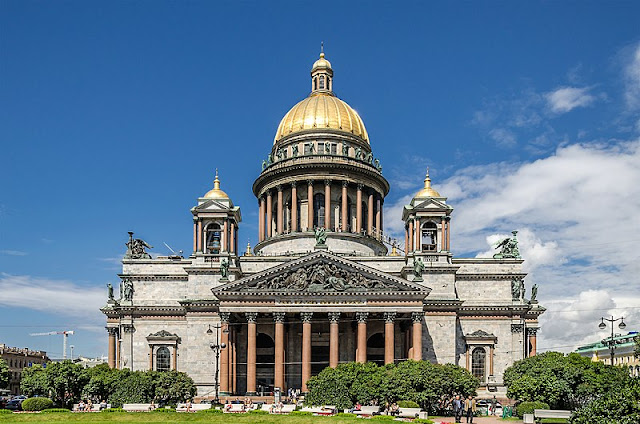One of the most intriguing cities in the world, the elegant St Petersburg is known for wonderful architecture and great squares. Built in 1703 by Peter the Great, as Russia’s “Window to Europe”, this former Russian capital is synonymous with several revolutions. Major highlights of the St. Petersburg city tour include the Church of the Savior on Spilled Blood, the imposing façade of St. Isaac's Cathedral, and the world-renowned Hermitage Museum, known for its huge collections of arts.
The Admiralty
Built to feed Peter the Great's ambition of making Russia into a naval power, Admiralty building is a major highlight of any visit to St Petersburg. What makes Admiralty a compelling attraction is its ever glistening 61m-high (200-ft.) spire topped by a weather vane in the shape of a ship. Formerly a fortified shipyard, the edifice is now used as a naval academy. Here you will find at the nexus of three main avenues of St. Petersburg's - Nevsky Prospect, Gorokhovaya Street, and Voznesensky Avenue. Though Admiralty is off limits for the visitors, the grounds are worth a stroll.
St. Isaac's Cathedral (IsaakevskySobor)
 St Isaac’s Cathedral / Image source
St Isaac’s Cathedral / Image source Hailed as the world’s largest orthodox basilica, the majestic 101m-high domed St. Isaac's Cathedral is a prime religious site in St Petersburg. The viewing balcony around the gold-plated dome of this 19th-century Cathedral offers an amazing view of the city. Its interior features marble floors wall and ceiling frescoes displayed on the ceiling. It is dedicated to Saint Isaac of Dalmatia, a patron saint of Peter the Great.
Fine Arts Square (PloshchadIsskustv)
Originally designed by Carlo Rossi between 1820 and 130, an Italian-Russian architect, Fine Arts Square (PloshchadIsskustv) is a crucible of several cultural and artistic institutions including Mikhailovsky Palace (now the Russian Museum). Other buildings built on this tree-lined square are Ethnography Museum, Mussorgsky Theater, Operetta Theater, and Philharmonic. The statue of the great Russian poet Pushkin, built in 1957, stands in the heart of the square.
Smolny Cathedral
Originally designed for Peter the Great's daughter Elizabeth, sky-blue Smolny Cathedral ranks among the masterpieces of century Italian sculptor BartolomeoRastrelli. Located on the bank of the River Neva, the cathedral is now used mainly as a concert hall.
Bronze Horseman (MednyVsadnik)
Bronze Horseman should be high on the list of the best attractions of St. Petersburg. Commissioned by Catherine the Great in honor of her grandfather-in-law and designed by French sculptor Etienne Falconet, this most famous of St. Petersburg's monuments depicts Peter the Great in all his ferocity.
Hermitage Museum
 Hermitage Museum / Image source
Hermitage Museum / Image sourceNo visit to St Petersburg is complete without a trip to the Hermitage Museum.One of largest, oldest and most well-known museums in the world, the State Hermitage houses over 3 million items dating from prehistoric to modern times. Located in the historic and resplendent Winter Palace, a former residence of the czars, the museum, founded b Catherine the Great in 1764, has some of the world’s biggest collections of paintings, including masterpieces by Leonardo da Vinci, Rembrandt, Picasso, Raphael and Van Gogh.
So what are you waiting for? Come and explore the city’s fascinating history as well as its contemporary culture. St Petersburg will not disappoint you.




No comments:
Post a Comment